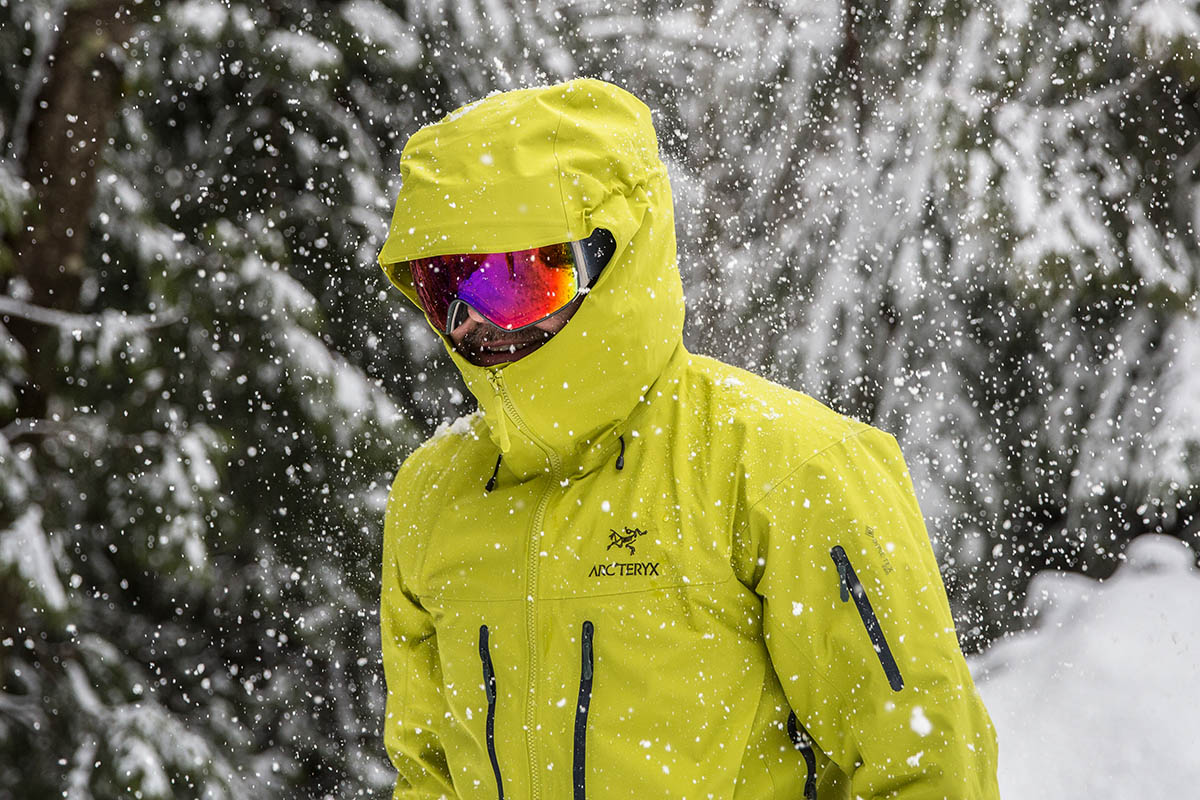
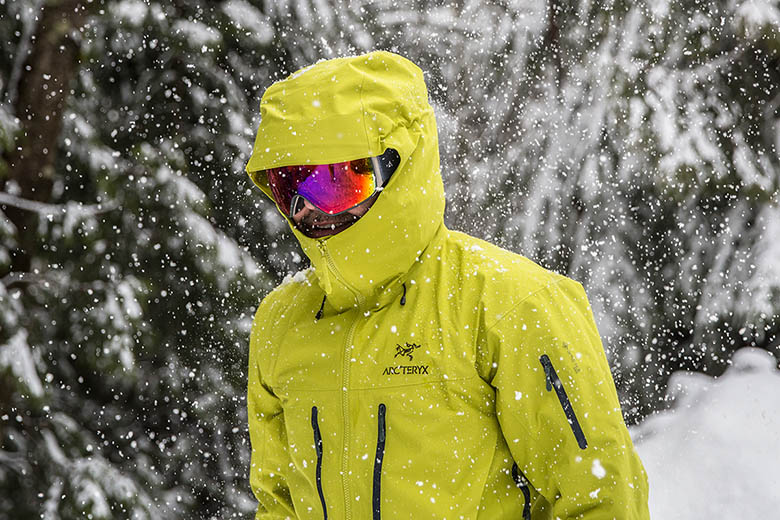
Price: $900
Weight: 1 lb. 2.5 oz. (men’s large)
Waterproofing: 3L Gore-Tex Pro Most Rugged
Denier: 100D
What we like: Bombproof protection, top-notch build quality, and fantastic fit.
What we don’t: Extremely expensive and overkill for many outdoor activities.
See the Men's Arc'teryx Alpha SV See the Women's Arc'teryx Alpha SV
Arc’teryx is no stranger to hardshell jackets and long has been a go-to option for protection in harsh mountain environments. At the very top of their lineup is the Alpha SV ("severe weather"), which is designed for use in the most serious of conditions. Arc’teryx updated the shell recently with a more durable Gore-Tex Pro construction, RECCO reflector, and revised zipper pulls, but the winning recipe remains. If you can swallow the high price tag, it’s an ideal jacket for multi-day ski tours, mountaineering objectives, and alpine expeditions where extreme weather is a concern. Below are our experiences with the Alpha SV. To see how it stacks up to the competition, check out our article on the best hardshell jackets.
Editor's note: The Alpha SV remains mostly the same since we published this review, though a few things seem to be improved, namely the use of 100% recycled materials and upgraded lamination to help increase lifespan and make repairs easier. We're currently in the process of testing the latest design and will update this review with our feedback once we do. In the meantime, you can check out the most current version of the Alpha SV Jacket here. Thanks!
The prior-generation Arc’teryx Alpha SV was a stalwart in rough and rowdy conditions, and the latest version of the jacket carries the torch. First and foremost, the 3-layer Gore-Tex Pro with Most Rugged build is essentially bombproof—the material is a substantial 100-denier, and Gore’s Pro membrane and fabric is known for its standout weatherproofing. For added assurance, you also get a durable water repellent (DWR) finish on the exterior to bead up moisture, as well as top-quality taped seams and WaterTight zippers to seal out precipitation. In practice, the jacket has deftly fended off everything from freezing spring drizzle and wet, heavy snow to dry, bitterly cold winds and rain typical of the Pacific Northwest. After numerous backcountry days in harsh alpine conditions, I have yet to have any moisture penetrate the fortress-like shell.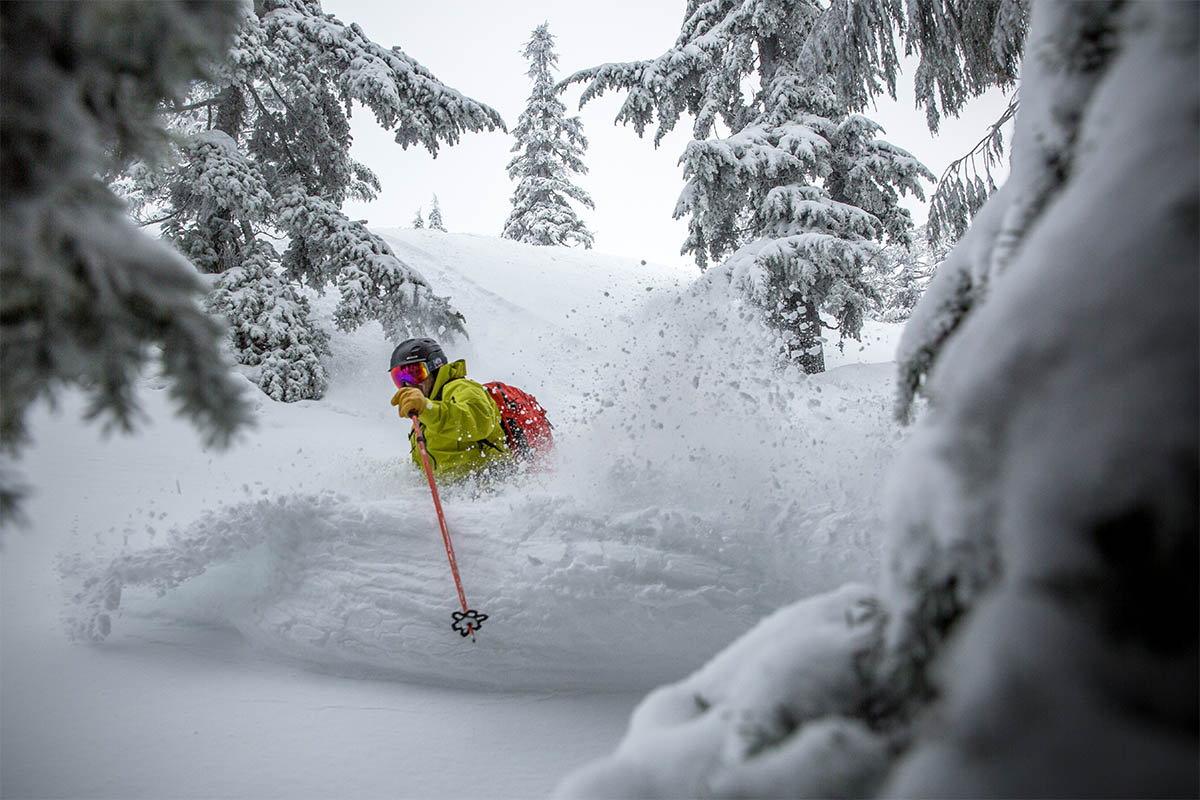
As far as other protective features go, the Alpha SV makes no concessions. The helmet-compatible StormHood is easily adjustable, highly protective, and offers excellent coverage without impacting field of view (more on this below). Combined with the tall collar, the aperture leaves only my nose and goggles exposed to the elements. Further, I’m a big fan of the Velcro cuff adjustments, which easily secure either over my undercuff gloves (the Black Diamond Dirt Bag) or under my gauntlet-style mittens (Arc’teryx’s own Alpha SV mitts). And although not technically waterproof, the jacket’s WaterTight zippers have not allowed moisture to penetrate the shell. In fact, I trust them enough to keep my cellphone, map, and even camera lenses dry and protected. Finally, the center back length (listed at 30.75 in.) provides ample coverage and prevents snow and drafts from creeping in while skiing or bending down.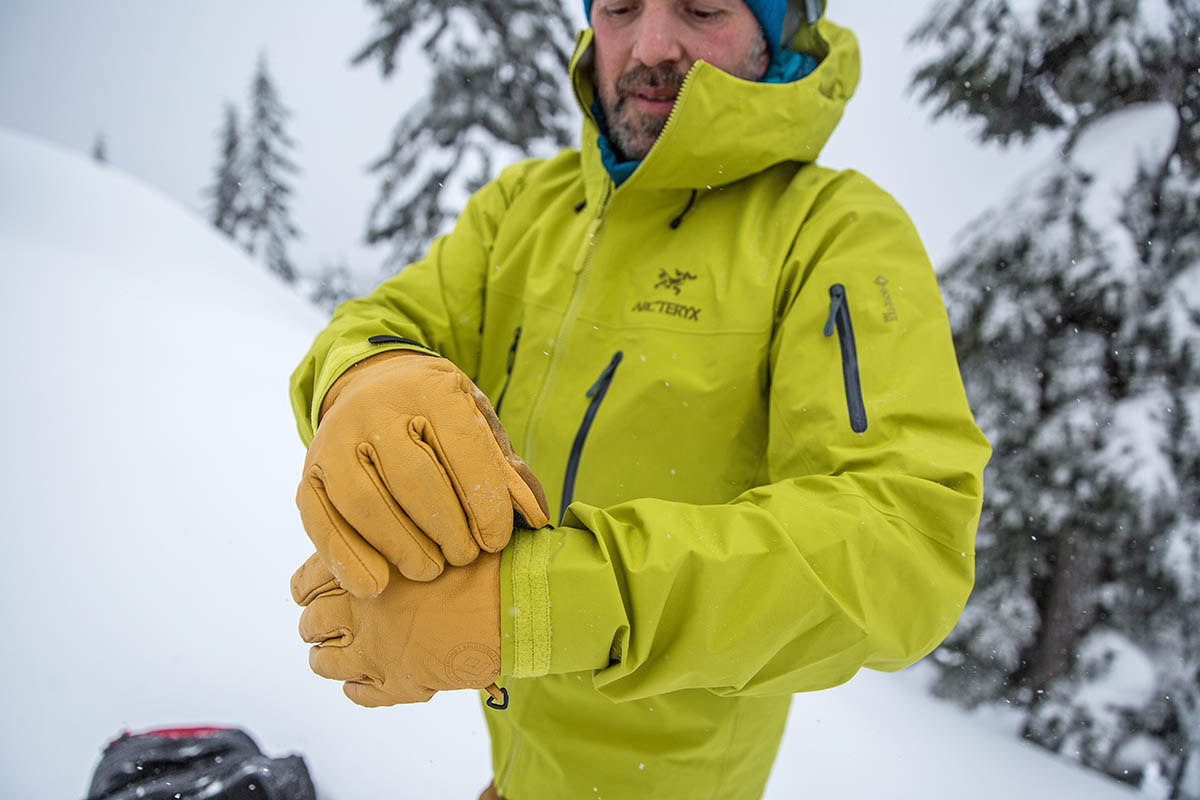
As with all Gore-Tex shells, I try not to wear the Alpha SV when exerting as I tend to heat up quickly. When backcountry skiing or hiking in the alpine, for instance, I reserve the shell exclusively for transitioning and descending. That said, when temperatures dip below around 15-20 degrees Fahrenheit, I’m able to comfortably wear the jacket during shorter bouts of activity without breaking into a sweat. And the pit zips (which are around 16 in.) are a lifesaver in such situations and work effectively, especially when also lowering the main zipper a bit for fresh air. In fact, with the zippers open, I’ve even been able to climb steeper, more technical slopes while adventuring in the alpine (although I wasn’t carrying my heavy ski gear, which helped). And I should note that I do prefer the larger pit zips found on my Norrøna shells, including the Trollveggen and Lofoten Gore-Tex Pro jackets, but the Alpha SV’s are perfectly adequate for most uses.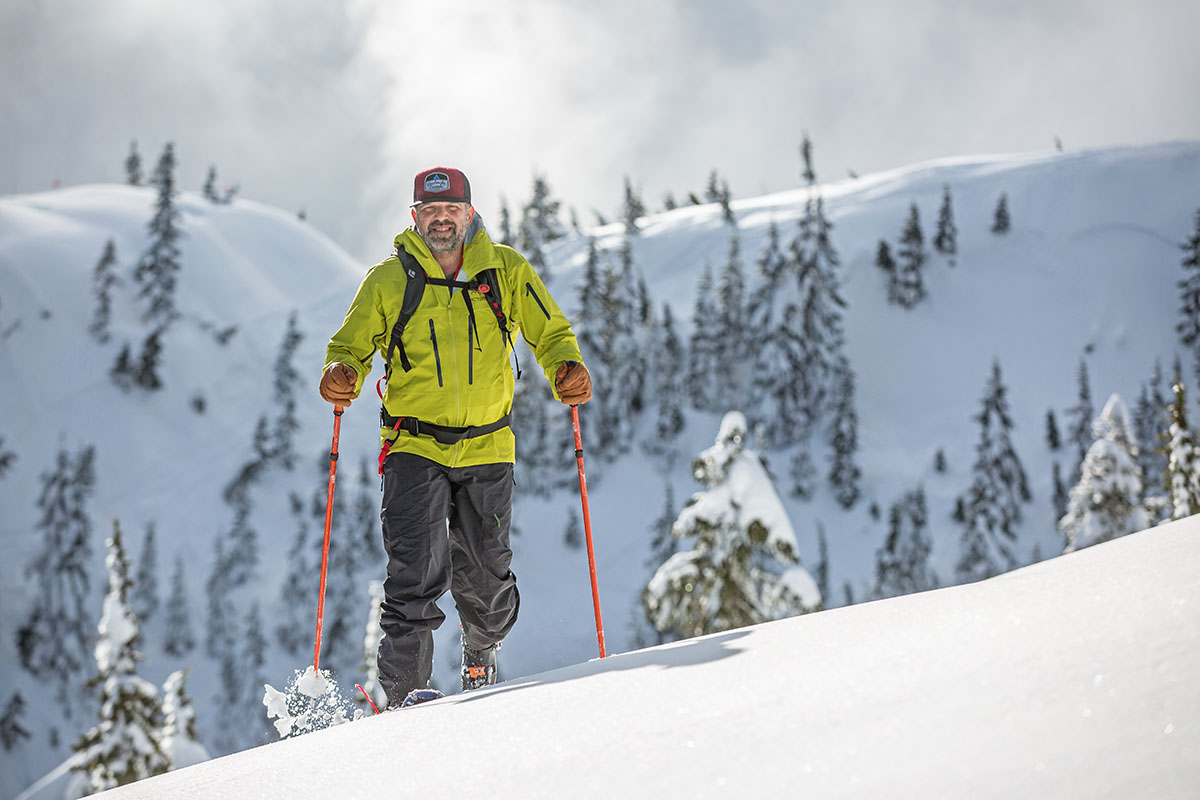
With gusseted underarms and articulated patterning, the Alpha SV offers nearly unrestricted mobility. This has been especially apparent during movement-dependent activities like transitioning, crouching down awkwardly while photographing, or loading gear in and out of my van. My only notable complaint is that Gore-Tex Pro isn’t the quietest or most comfortable fabric, especially when I work up a sweat, but the interior of the shell does slide nicely over most of my midlayers. And a smaller gripe is that I wish the main zipper were two-way rather than one-way, which would allow easier access to a harness and prevent the shell from bunching and tightening when I sit down. I’m honestly a bit surprised by this omission given the Alpha’s mountaineering-focused build, but again, it’s not a big deal by any means.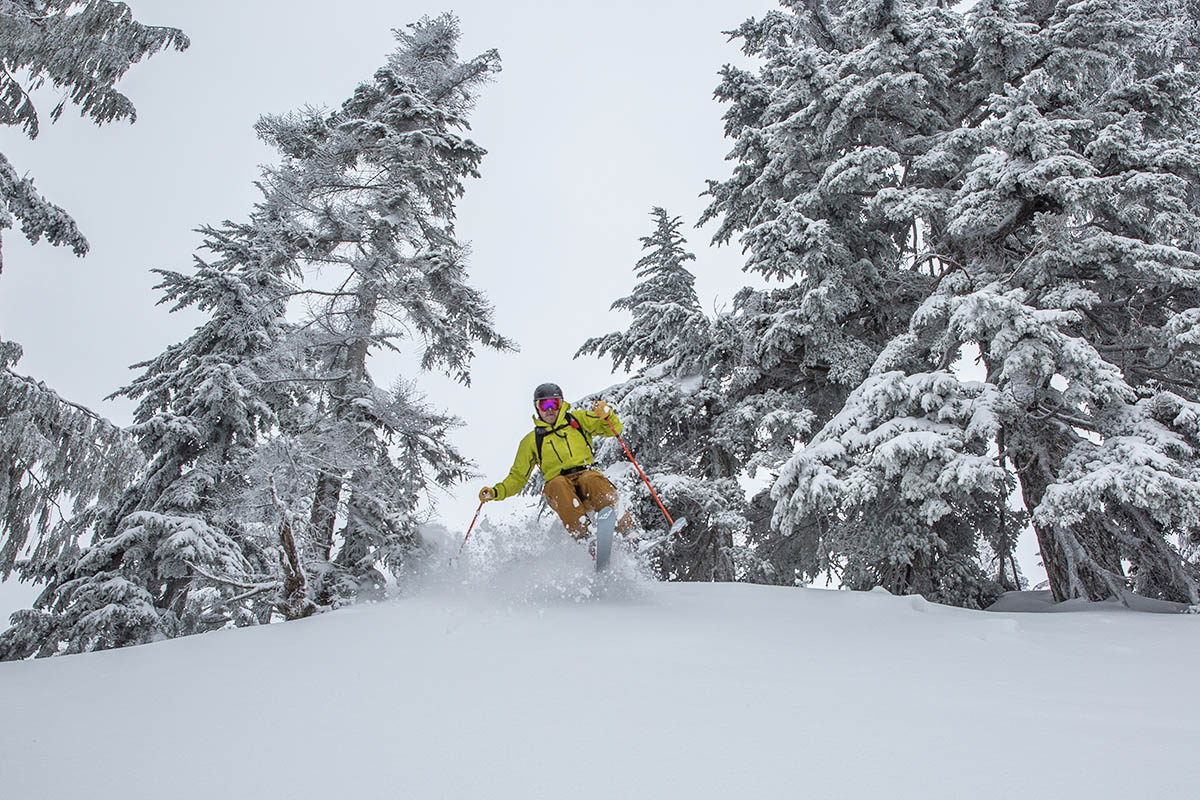
The Arc'teryx Alpha SV's 100-denier, 3-layer Gore-Tex Pro with Most Rugged build is touted as being extremely durable and abrasion-resistant, and thus far, it has lived up to the hype. Despite repeated exposure to snow, rocks, and even a few unexpected run-ins with trees, the shell still looks and feels like new. And importantly, the Alpha SV has retained its water- and windproofing with no signs of wetting out to date, even after months of use in harsh winter conditions. Additionally, all zippers, seams, and drawcords are intact and operating flawlessly despite the shell being shoved into and pulled out of my pack, thrown haphazardly into the back of my van, and generally intertwined with sharp backcountry ski gear like crampons and my shovel, probe, and snow saw. All in all, the Alpha SV has certainly taken a beating but remains in impeccable condition.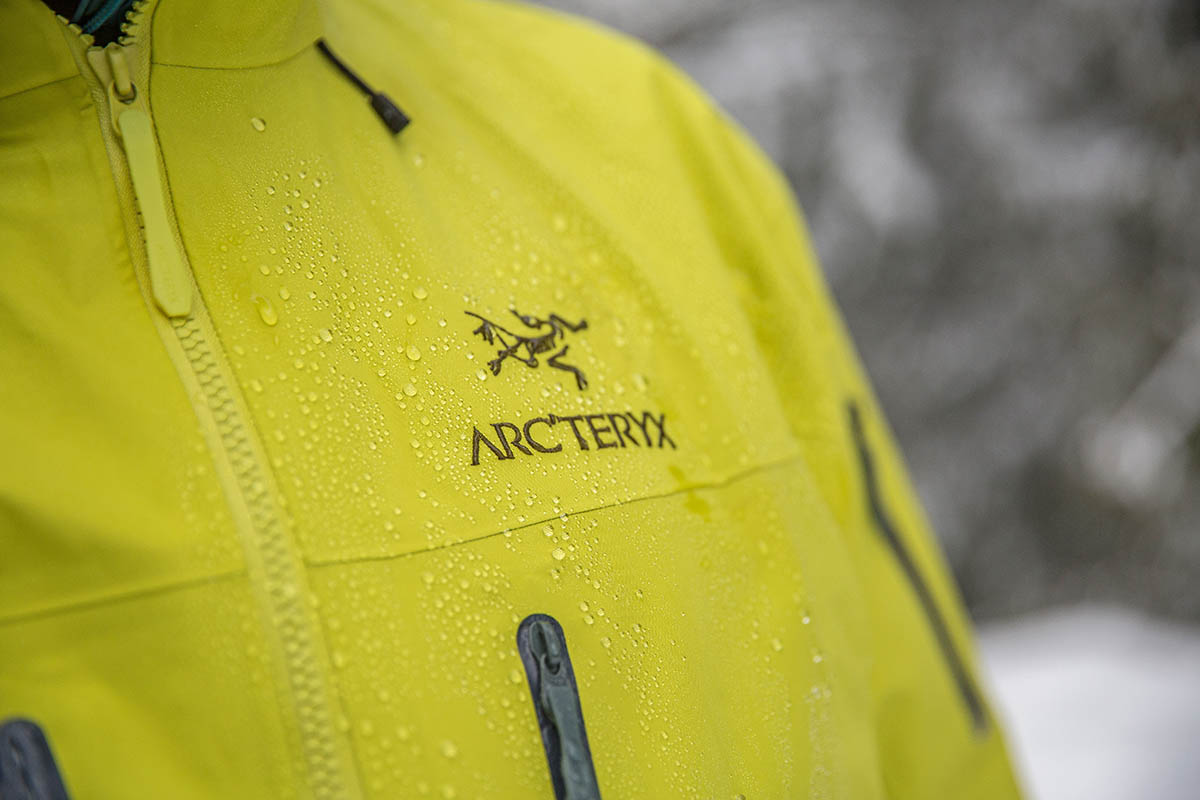
My men’s large Alpha SV weighs in at 1 lb. 2.5 oz. (the listed weight is 1 lb. 2 oz.), which isn’t ultralight by any means but is an impressive feat for such a burly jacket. For reference, it considerably undercuts the similarly mountain-ready Norrøna Trollveggen (1 lb. 6.9 oz.) and weighs around the same as Mountain Equipment’s Lhotse (1 lb. 1.6 oz.), while beating both alternatives in durability. And importantly, despite its noticeably robust build, the Alpha SV still packs down reasonably small into its own hood (it can be compressed to under a liter, which is largely due to its streamlined feature set). All things considered, Arc’teryx packed truly standout protection into a light and packable design, and I have no concerns about bringing the Alpha SV on multi-day outings deep into the backcountry. 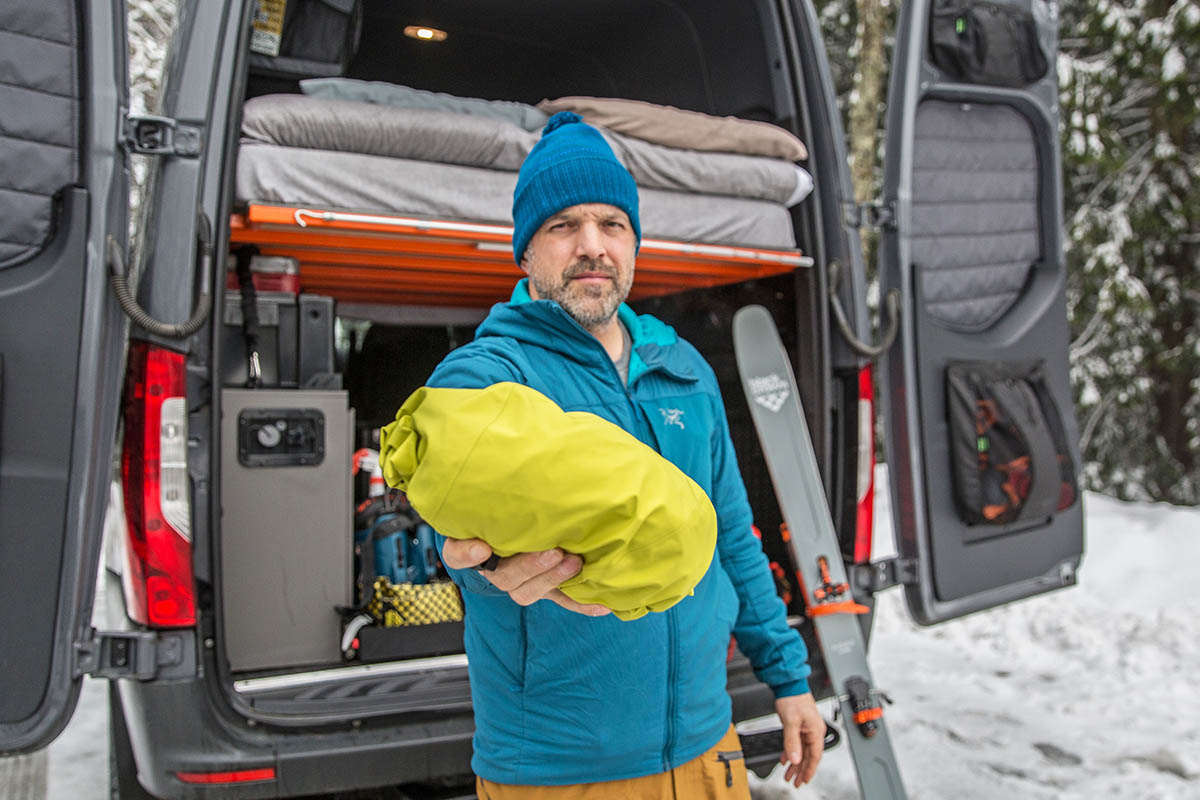
Put simply, I’m a huge fan of Arc’teryx’s StormHood design. Although not a ski-specific shell, the Alpha SV’s hood is helmet-compatible—I’ve been able to wear both my Smith Quantum and Vantage underneath, as well as a lower-profile climbing lid—and leaves only my goggles and nose exposed when fully tightened. To snug down the hood, four cord adjusters on the sides and back cinch the neck area, brim, and aperture, and releasing is as simple as squeezing the toggles. The two rear tabs are small and a bit hard to manipulate with bulky ski gloves on, but all other adjustments are easy. And importantly, I’ve been able to customize fit regardless of whether I’m wearing a helmet or only a light beanie, and the hood has never obstructed my vision in any direction. Additionally, there’s no restriction to side-to-side head movement (a fairly common issue with hardshells), and the laminated brim gives the hood structure and effectively keeps precipitation out of my face. 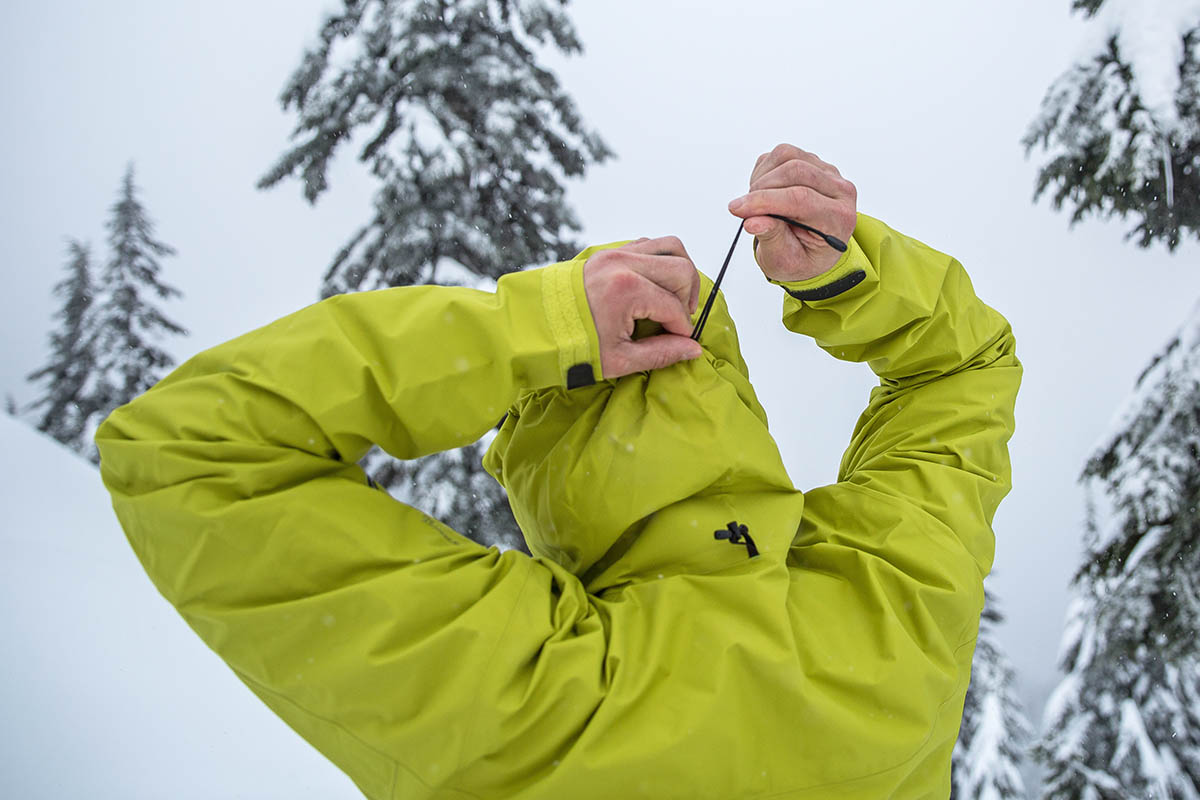
At first glance, the Arc'teryx Alpha SV’s WaterTight zippers with RS sliders might look fairly average, but there is a subtle and key difference. Zippers typically leave a very small gap at the top where they don’t quite complete the seal, so manufacturers need to add a small hood or “garage” to stop water from entering. This adds weight with the extra material and stitching. The Alpha SV's RS Slider eliminates the need for this “garage” by allowing the zipper to continue up to and seal at the very top. In use, the zipper design works seamlessly. And although Arc’teryx adds the disclaimer that their WaterTight zippers are highly water-resistant and not waterproof, I have experienced no leakage through any of the zippers and have been comfortable leaving valued items such as my phone or a map in the pockets.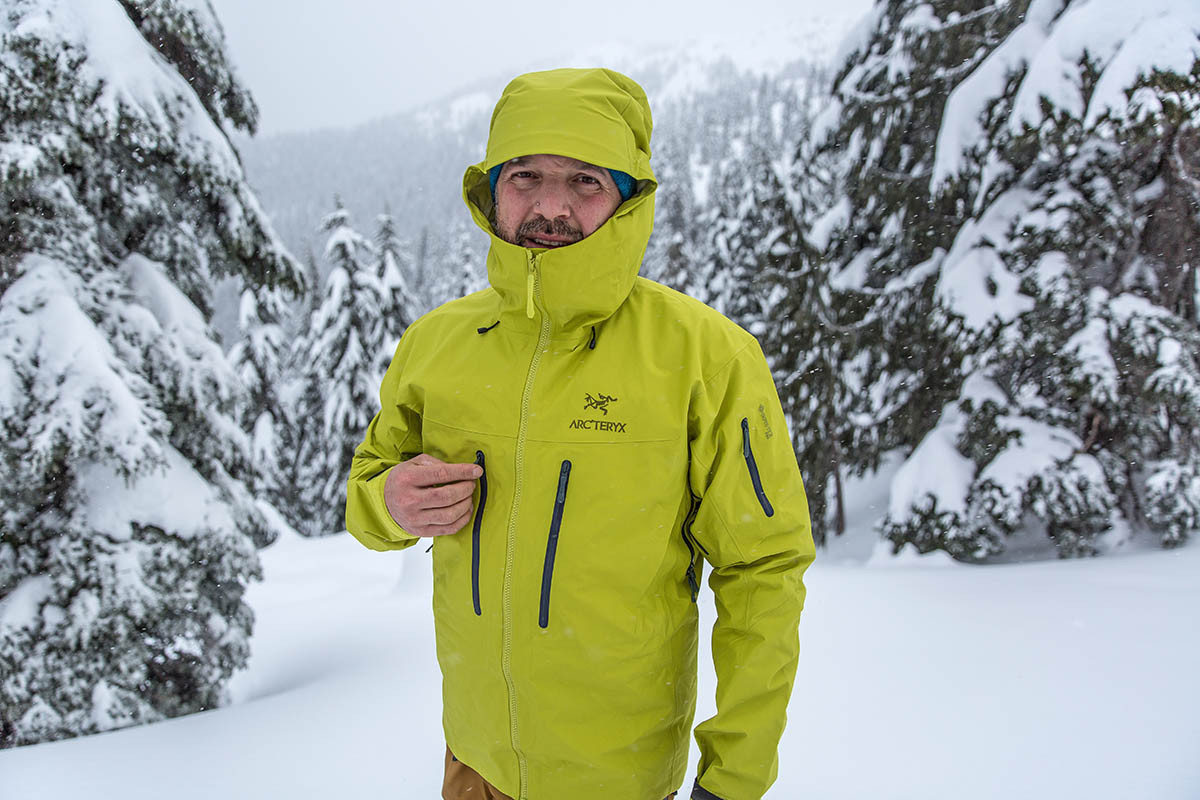
The Alpha SV comes equipped with five total pockets: two chest pockets, a bicep pocket, a laminated internal pocket, and an internal dump pocket. The Napoleon chest pockets are situated high on the chest for easy access while wearing a pack or harness, and they're large enough to stow my two-way radio, spare camera lens, or Garmin inReach device. And while I personally prefer traditional hand pockets over this cross-body layout for warming cold hands, the tradeoff is that you get convenient access while belaying. Rounding out the external storage, the Alpha also has a sleeve pocket for a ski pass or credit card/license. And on the inside of the jacket, the mesh dump pocket at the right side is great for stashing goggles, gloves, or climbing skins, and a small laminated pocket on the left side is nice for smaller items like a cellphone or map.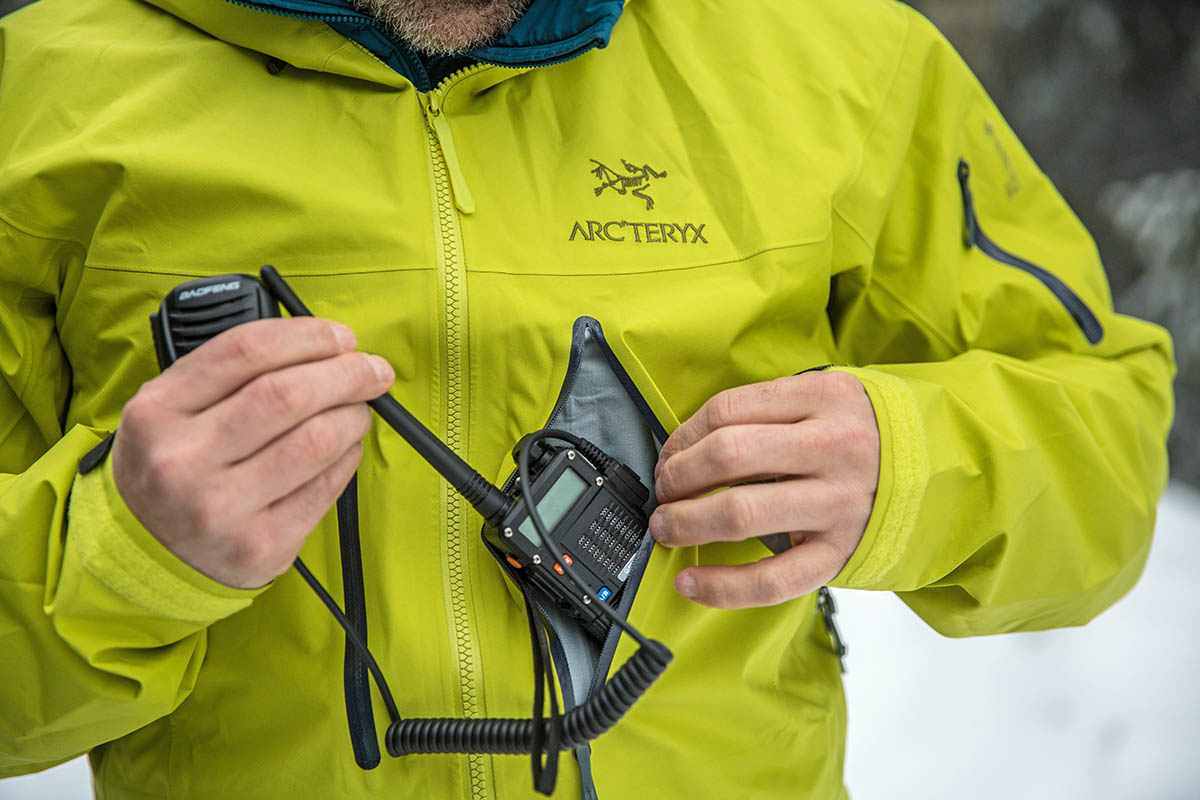
As with almost all their apparel, Arc’teryx’s Alpha SV hits that highly sought-after balance between an athletic fit and enough room for layering. I typically wear a men’s size large and found the Alpha SV is true to size. The jacket is roomy enough for a warm midlayer (I wore the Arc’teryx Proton LT or Cerium SL hoodies for most of this test) but fitted to avoid bunching up or flapping in the wind. It also has a long enough back length (it’s listed at 30.75 in.) to provide excellent coverage when skiing, and it hasn’t bunched up under my pack’s hipbelt. In short, this premium fit is one of the reasons I love Arc’teryx products.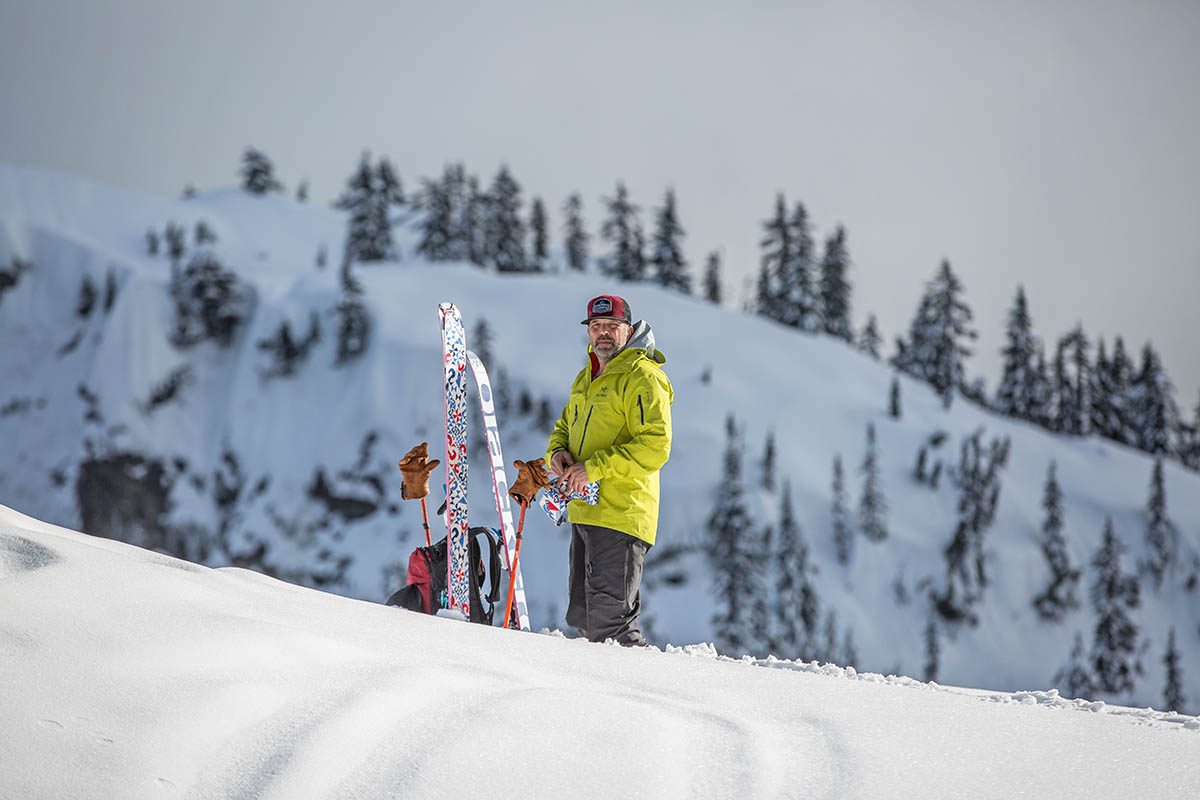
We tested the men’s version of the Alpha SV jacket, and Arc’teryx also makes a women’s-specific model. The design is nearly identical: it has the same 100-denier Gore-Tex Pro with Most Rugged build, pocket layout, tough StormHood, and $799 price tag. Because of its smaller fit, the women’s SV is a little lighter at 15.5 ounces compared with 1 pound 2 ounces for the men’s. In addition to the jackets, the Alpha SV line also includes an alpine-ready bib pant (only available currently in men’s sizes). It’s a super burly 3-layer design with an 80-denier face fabric (150D in high-stress areas), extended coverage that reaches midway up the chest, and long side zips for dumping heat. Purchasing the full Alpha SV kit will set you back a staggering $1,448, but it delivers unmatched levels of hardshell protection.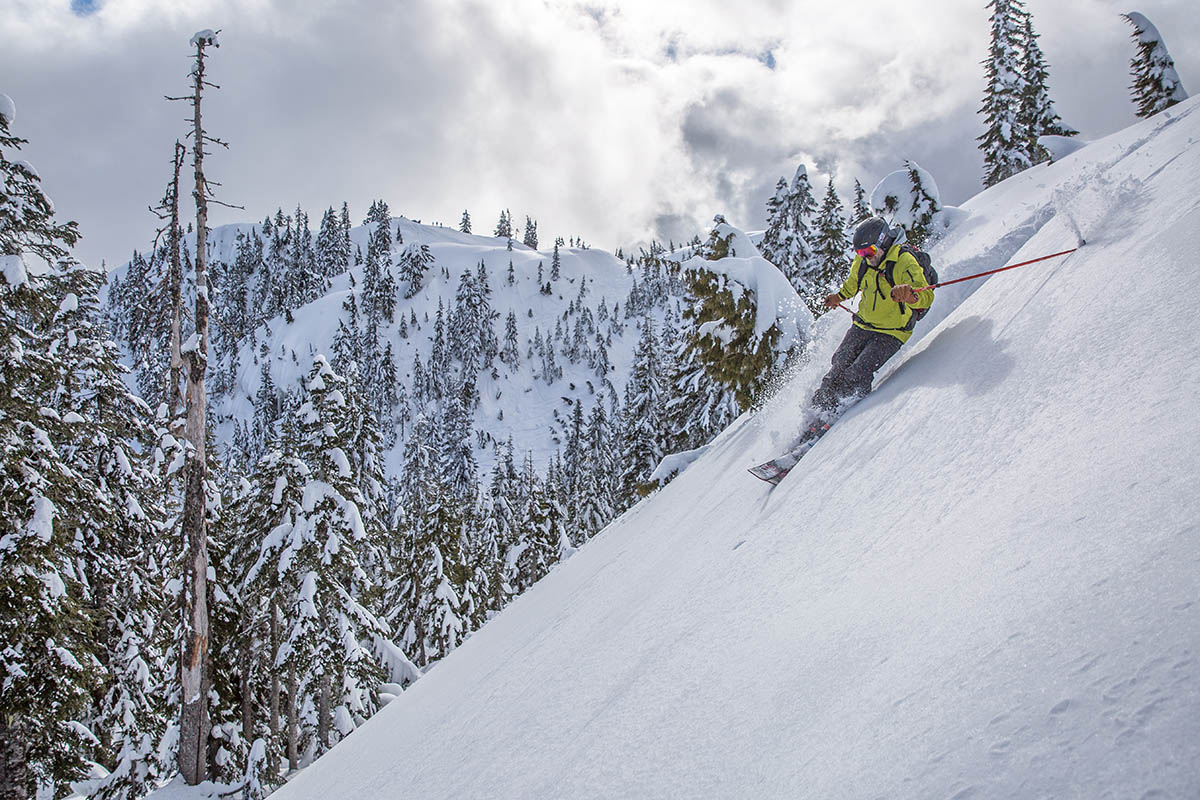
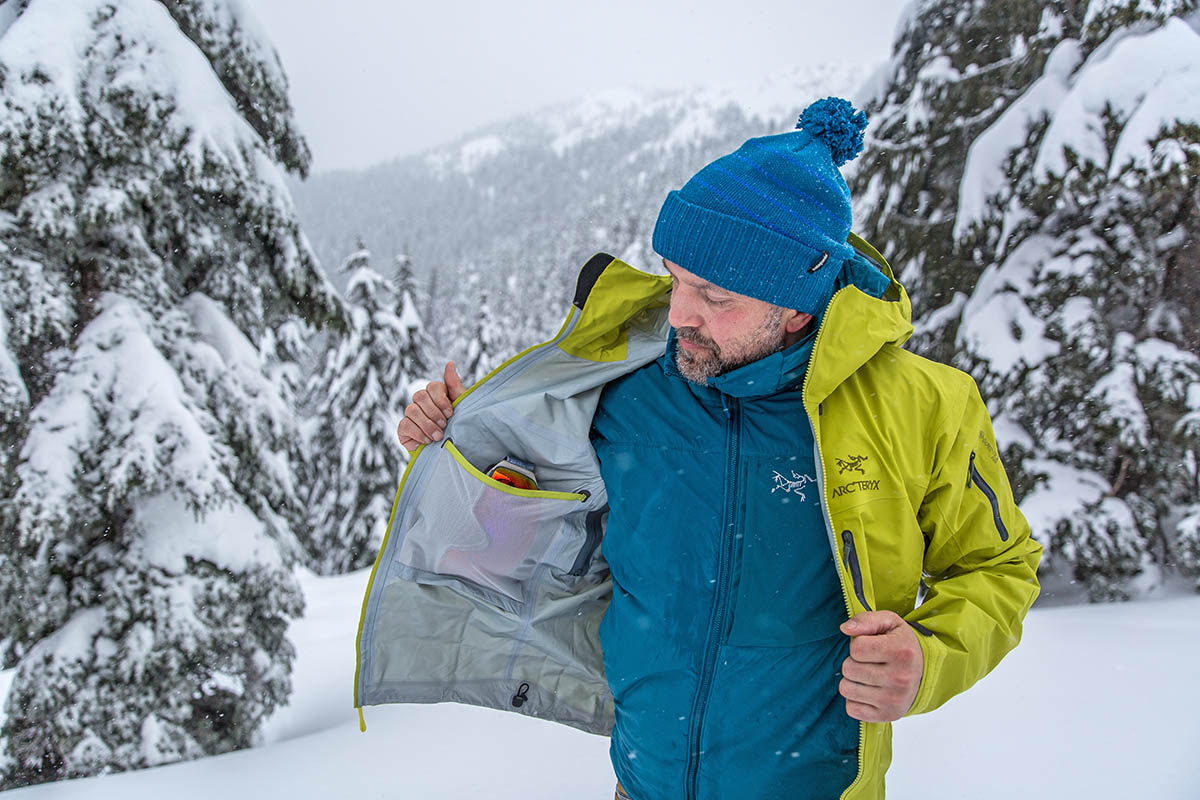
| Jacket | Price | Weight | Waterproofing | Denier | Pit Zips | Pockets |
|---|---|---|---|---|---|---|
| Arc'teryx Alpha SV | $900 | 1 lb. 2 oz. | 3L Gore-Tex Pro | 100D | Yes | 5 |
| Norrøna Trollveggen | $649 | 1 lb. 6.9 oz. | 3L Gore-Tex Pro | 70D | Yes | 4 |
| Mammut Nordwand Pro HS | $850 | 1 lb. 5.8 oz. | 3L Gore-Tex Pro | 80D x 80D | Yes | 7 |
| Arc'teryx Beta AR | $600 | 1 lb. | 3L Gore-Tex Pro | 40D x 80D | Yes | 3 |
| Arc'teryx Alpha AR | $700 | 15.2 oz. | 3L Gore-Tex Pro | 40D x 80D | Yes | 3 |
| Mountain Equipment Lhotse | $600 | 1 lb. 1.6 oz. | 3L Gore-Tex Pro | 40D x 80D | Yes | 4 |
The Alpha SV is in the upper stratosphere of hardshell jackets, and consequently its direct competition is somewhat limited. Norway-based Norrøna makes an appealing Gore-Tex Pro shell for all things alpine called the Trollveggen GTX that undercuts the Alpha in price at $649. Feature-wise, the two jackets have a lot in common with chest pockets (the Norrøna also has standard hand pockets), helmet-compatible hoods, and pit zips (although the Trollveggen's design allows you to dump heat more efficiently). The Trollveggen uses a thinner 70-denier face fabric and weighs more (1 lb. 6.9 oz. compared to 1 lb. 2 oz. for the Arc’teryx), but we found it to be similarly durable in use and think that the added weight is well-spent. We’d still go with the proven SV as the bomber yet light alpine choice, but the Norrøna is no slouch and saves you a considerable $150.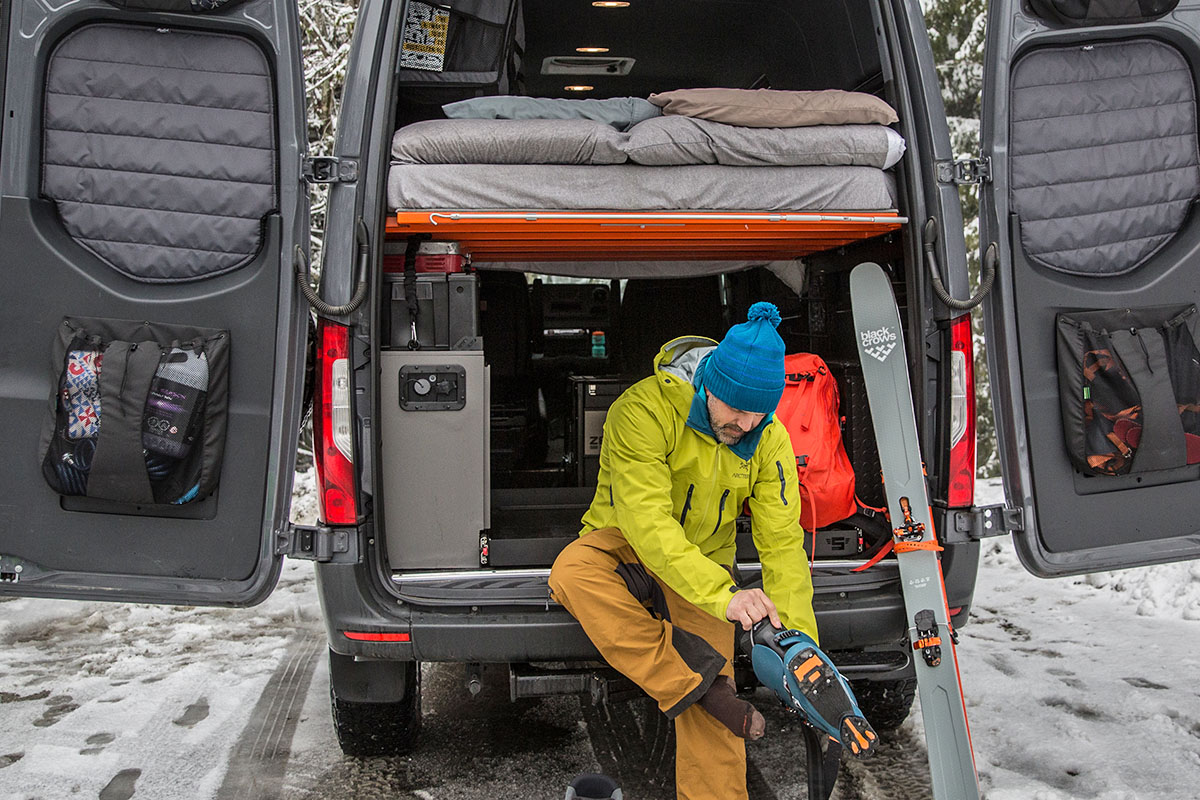
Another intriguing alternative is Mammut’s top-end Nordwand Pro HS. Like the Alpha SV, the Nordwand is designed for serious alpine missions and backcountry pursuits with a robust Gore-Tex Pro build, climbing-focused features, and excellent all-around protection. In parsing out the differences, the Mammut is slightly thinner with an 80 x 80-denier face fabric, although it’s undeniably tough and also includes Gore’s Most Rugged technology for added abrasion resistance. Further, we like the panels of Gore’s new Pro Stretch material, which help maximize range of motion and overall comfort. We rank the Arc’teryx higher in our hardshell round-up because it’s cheaper, lighter (you save $26 and 3.8 oz.), and has a longer track record, but the Mammut gets you added features including a zip-out powder skirt, two-way main zipper, and more pockets.
Arc’teryx is a leader when it comes to serious hardshells, so some of the toughest competition for the Alpha SV is in-house (it’s important to note that Arc’teryx tailors each of their pieces for specific uses, so it’s often not a matter of which jacket is better overall but which jacket is best for what you’ll be doing). The Alpha SV sits at the top of their hardshell lineup in durability and weather protection, but if you don’t need the most bomber set-up, Arc'teryx's Beta AR hits a nice middle ground. This stalwart shell is strong enough to handle some rough alpine treatment, shaves off 2 ounces, packs down a bit smaller, and includes hand pockets. That said, the Beta’s offsetting 40- and 80-denier fabric is less of an impenetrable fortress than the 100-denier Alpha and its back length is a bit shorter, which make a difference for skiing and in truly rough conditions (for more information, see our in-depth Beta AR review).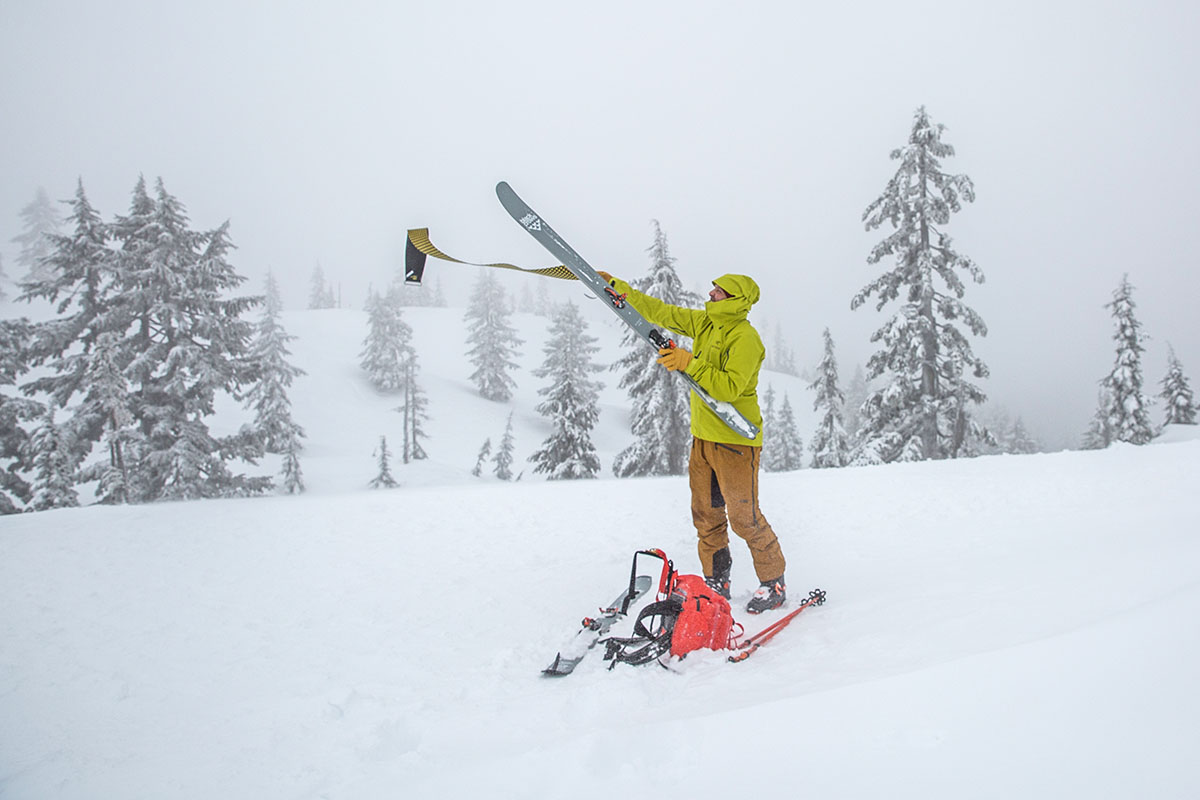
Another shell to consider comes from within Arc’teryx’s same climbing-focused Alpha line: the AR (“all round”). As its name suggests, the $599 AR is a little more versatile than the SV, designed for a wide range of alpine conditions with a moderately thinner Gore-Tex Pro build (40D and 80D) and lighter weight (15.2 oz.). Both have a long cut for excellent protection, include sturdy and helmet-compatible hoods, and leave enough space for layering underneath, but we can’t help but come back to the Alpha SV’s notable advantage in the absolute worst of conditions. If you need the best of the best, the SV is the one to get.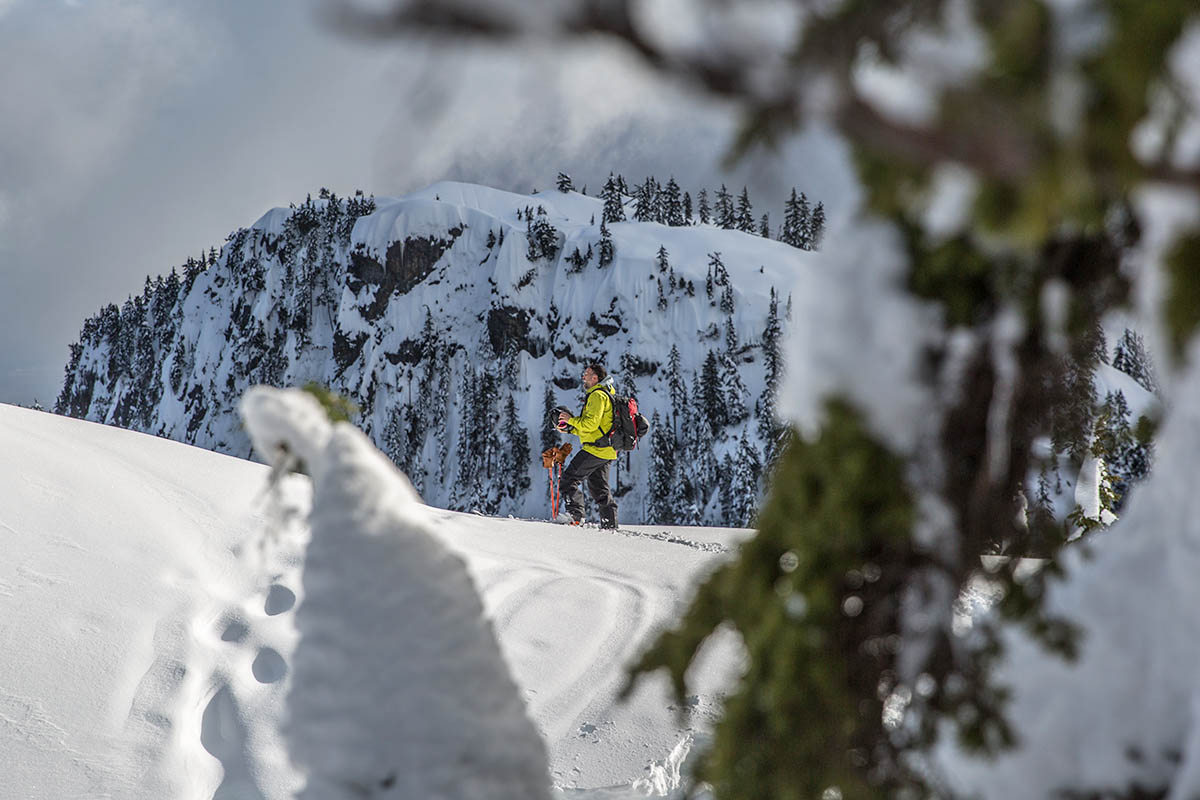
A final alpine-ready shell to have on your radar is Mountain Equipment’s Lhotse. Both jackets use top-end Gore-Tex Pro waterproofing, feature tall collars and hipbelt-friendly chest pockets, have longer back lengths for increased coverage, and weigh around the same (the Lhotse clocks in at 1 lb. 1.6 oz.). However, the Mountain Equipment lacks the bombproof feel of the Alpha SV with a thinner 40-denier shell (it has 80D reinforcements in high-wear areas). And while the Lhotse undercuts the Alpha SV by around $200, availability in the U.S. can be limited. For these reasons, we think the Arc’teryx is worth the added investment.
If you’re thinking about buying gear that we’ve reviewed on Switchback Travel, you can help support us in the process. Just click on any of the seller links above, and if you make a purchase, we receive a small percentage of the transaction. The cost of the product is the same to you but this helps us continue to test and write about outdoor gear. Thanks and we appreciate your support!
Depending on the seller, most products ship free in the United States on orders of $50 or more. International shipping availability and rates vary by seller. The pricing information on this page is updated hourly but we are not responsible for inaccuracies.